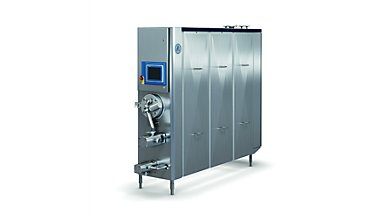4 secrets to successful ice cream production

Tip 1: Standardize your process so your products always hit the sweet spot
Consistency is king in ice cream production. Consumers expect each mouthful to offer the same delicious taste and mouthfeel. But uneven product quality not only risks consumer disappointment – it will also inflate your costs.
Ice cream products that fail to meet the minimum required weight, for example, will need to be discarded. Weight deviations are typically not detected until late in the process, after the ice cream has, say, been extruded, covered with chocolate and dipped in nuts. These ingredients are expensive and wasting them will hurt your bottom line.
Sometimes producers overfill their products to ensure they achieve minimum weight, but this again involves a deliberate waste of expensive raw ingredients.
So what is the answer? First, you need a precision process capable of delivering a uniform product. That requires a high-quality freezer.
Choosing the right freezer is essential for ensuring high product repeatability and for minimizing costs. Pay close attention to the freezer pumps. These must be of high quality and maintained in top working order to keep the pressure inside the freezer high and stable. Pressure fluctuations are likely to cause product weight to vary.
Second, ensure that your dasher – a core component inside the freezer cylinder – runs at the right speed. If it turns too slowly, it will not agitate the ice cream sufficiently. This can cause poor air distribution and yield products that are underweight, overweight or in between.
Third, make sure your recipe is optimized to contain the correct proportions of stabilizers, emulsifiers and sugars. Producers sometimes streamline their mix by choosing lower-cost ingredients. But this can have a negative effect on product uniformity.
Look for a supplier that can offer product development expertise specific to ice cream formulations. And make sure your freezer can handle your specific recipe. You may need to consider supplementary equipment or process adjustments to get your mix just right.
Tip 2: Minimize product waste during production start-up
When starting a production run, a freezer always needs time to reach production readiness and to get the texture and structure of your ice cream just right.
The start-up phase always results in some initial product being lost. Typically these losses may be around 40-60 litres. Depending on your freezer type and design, the lost volume may be as high as 160 litres.
Some freezers come with a fast start-up system that can reduce losses to as little as 20 litres. Such freezers are fitted with extra start-up valves that can shut off the product flow to the freezer cylinder, enabling the right processing conditions to be achieved inside the cylinder with minimal product throughput.
Traditional freezers often lack start-up valves. Ask your supplier for a model that includes this option. It will minimize your product losses and increase your margins.
Tip 3: Choose a freezer that can handle multiple product types
Freezer versatility is the name of the game in ice cream production. Perhaps you are producing standard ice cream today but may one day wish to grow your business by adding other products.
If so, it makes sense to choose a freezer that can handle a range of recipes without requiring supplementary equipment or changes to your production setup.
Multiple equipment installations are expensive and changeovers cost time and money. A versatile freezer that can handle all your products solves this issue. The key is to choose a freezer with a high “turndown ratio”, meaning it can produce at both high and low capacity.
Such a freezer will allow you to produce your basic product at high capacity one day and to produce a speciality product (which typically requires a slower production rate) the next. Flexible, scalable and versatile.
Contact your supplier, explain your requirements and ask about the turndown ratio of the equipment offered.
Tip 4: Maximize your production uptime
Production downtime due to cleaning is a necessary evil for any food processor. Ice cream is no exception.
Cleaning intervals vary between ice cream products. Some water-based ices tend to clog the freezer cylinder and require frequent cleaning. Cleaning intervals also vary widely between ice cream freezers. Some models can only run for three or four hours before requiring cleaning, which typically requires a line stoppage of one to two hours.
A freezer with a specialized beater – the knives inside the freezer cylinder that scrape and agitate the ice cream as it is processed – and related components can radically extend production uptime.
Depending on your production specifics, the knives inside a specialized beater can decrease your cleaning need by anything from 50 to 300 percent and generate huge cost savings.
The key is to ask you equipment supplier for a freezer that is designed to run for the number of hours you actually want it to run for. Some freezers may need to be cleaned once or more a day. Others can run for a week between cleans.
Make cleaning a key discussion point in your dialogue with the equipment supplier.





